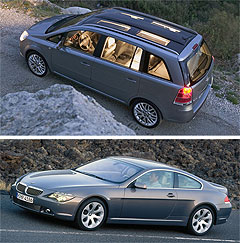Make / Model Search
News - General News - TechnologyHi-tech plastic to open green car doorsFlexible: Lexan plastic helps make Seat's Leon hatch look like a three-door. New materials and technology is set to change the automotive industry7 Apr 2008 A WORLD plastics expert believes that Australia’s car-makers and parts manufacturers will need to embrace new technology in order to meet future fuel consumption and design requirements. Sabic Innovative Plastics, a Saudi Arabian company that last year took over GE Plastics, has developed a lightweight alternative to automotive glass as well as a plastic material that recycles plastic bottles but does not possess the reduced properties of regular recycled plastic. Sabic’s global technical manager for body panels and glazing Frank Mooijman told GoAuto last week that these new developments would revolutionise the design and production of headlights, bumpers, rear quarter windows, tailgates and panoramic roofs in particular. A Dutch-based engineer, Mr Mooijman also previewed a new style of steering wheel made entirely without metal that could be moulded in any shape a designer desires. He expects such injection-moulded steering wheels to be in production within two years. Visiting Australia last week, Mr Mooijman demonstrated Sabic’s latest developments to OEMs and suppliers, underscoring the benefits of plastic in terms of design flexibility and light weight.  Left: Opel Zafira and BMW 6 Series. Left: Opel Zafira and BMW 6 Series.Half a century ago, GE invented Lexan, a bulletproof polycarbonate material that protects the eyes of racing drivers and motorcyclists around the world, and one of Sabic’s new products is Lexan glazing that Mr Mooijman said has “stormed the market”. Lexan glazing is half the weight of glass and, although also twice as expensive, would save up to 5kg for a Holden Commodore rear window. In the case of a panoramic roof on an SUV or people-mover, as on the latest European-market Opel Zafira, the weight reduces from about 40kg to 20kg and hence lowers the vehicle’s centre of gravity. “I think fuel consumption pressure will come here (to Australia), and if that starts to become a pressure, then look at all the parts that can save you weight,” said Mr Mooijman. “Really, everyone should be looking at glazing. With the current technology, it’s a no-brainer. You should look at opportunities there to take your weight out.” Sabic has developed defroster technology to enable Lexan glazing to be used for rear windows, but it remains too flexible to be used on wind-up side windows and is not legally permitted for windscreens, which must be made of glass. However, Sabic hopes that legislation will change in the future and in the meantime is working on new hard-coating so that plastic windscreens of the future will be sufficiently scratch-resistant to wipers. Lexan rear glass is being used on four production models globally, including the innovative wraparound “extra window” that brings a unique styling element to the tail of the British-built Honda Civic hatchback, as seen on the local market Civic Type R. The same material enabled Volkswagen-owned Seat to make its five-door Leon hatchback look like a two-door coupe by having a non-glass rear quarter window with a built-in recessed hand-grip that provides access to the hidden door-handles, so the rear doors do not have obtrusive handles. The complex shape exceeded the limitations of glass. “This is really new,” said Mr Mooijman. “Trains and trucks are a little further ahead because the requirements are different to automotive, where scratch resistance is really important. So there are only four (cars) on the market, but many more to come. “Traditionally, our contact is with engineers, but we do more and more with stylists because they drive new developments in the automotive industry. “Our customers need to save fuel but they also want to do designs that previously were not possible.” Sabic is also pushing plastic bumpers as a weight-reduction solution and already up to 25 models use them, including the Hummer, Renault Clio and Laguna, BMW 6 Series and a forthcoming Ford model. Why just bumpers? Well, mainly because of the savings associated with pressing dies, which cost millions of dollars, and the fact that up to five are required for pressing increasingly complex bumpers whereby only one is needed to injection-mould a plastic fender. Mr Mooijman said that plastic bumpers are ideal for production runs of 50,000 to 100,000 units a year. However, they are not suitable for cars with bumpers more than one metre in length because the plastic expands too much under the normal 200-degree online painting process. BMW gets around this by painting the 6 Series panels offline, but that can create paint-matching problems for volume producers. Sabic is working on new materials capable of withstanding the baking process. “Plastic fenders have been done in Europe for more than 10 years, with real large sales the last eight years, and for some it’s a no-brainer. If it’s a new model and it’s a somewhat smaller car with a good volume, they will do it,” said Mr Mooijman. Sabic’s new recycled – or “upcycled” – plastic is said to overcome the problem of other recycled plastic losing 40 per cent of its properties by extracting the oil from old bottles and using it to produce what is actually a fresh material. “The message is, it’s a new material,” said Mr Mooijman. “What we do is take a polymer (back) to its individual bits again and we rebuild these bits into a new polymer. It’s a new product, but it’s made out of landfill. “This polymer is a lot greener and in the automotive industry you can make body panels out of it, connectors, a lot of bezels in lighting, many underhood applications, door-handles, parts for the mirror – these are all possible.” |
Click to shareGeneral News articlesResearch General News Motor industry news |









Facebook Twitter Instagram